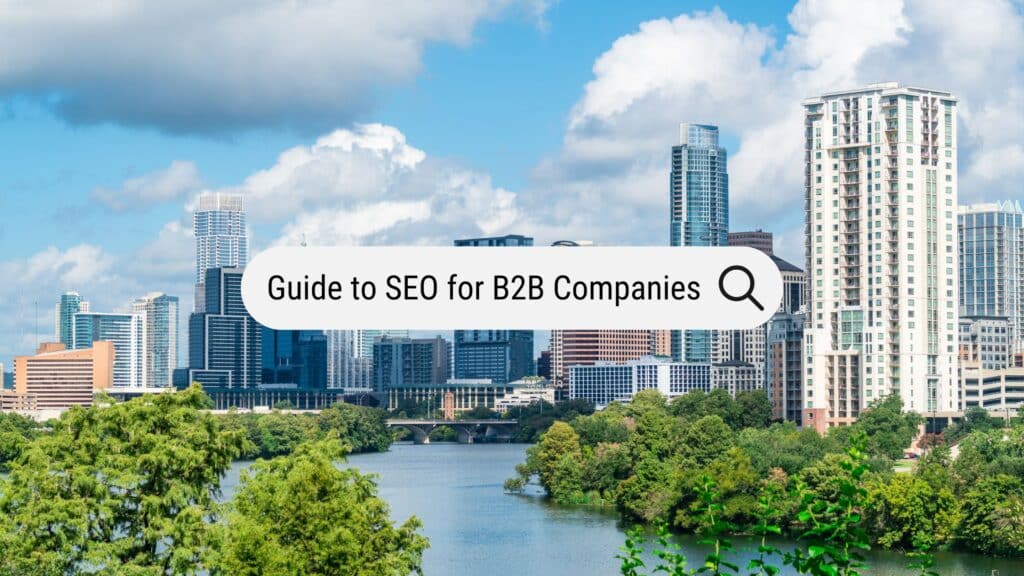SEO (Search Engine Optimization) is the process of generating organic (or unpaid) traffic to your website using strategically placed keywords and links throughout your website content and backend (or website building program). The goal of this strategy is to get your website and/or brand in front of people that would be ideal clients by ranking highly for topics they search for.
By increasing the number of people that recognize your brand, SEO increases the value of your brand and grows your audience. SEO also makes it easier for people that are looking for companies or services like yours to find you. This blog will cover the various phases of an SEO strategy for B2B companies.
Phase 1: Define Your Audience
Who is your ideal client? If you haven’t thought about this, or you have but you haven’t written it down, this is where B2B SEO strategizing begins.
In order to sell your services to other people or companies, you have to narrow down who you’re targeting. This means knowing what problems your ideal client faces and how your offering solves their problem and makes their lives easier. Most companies will define multiple buyer personas. These personas can be defined by the position the person has, their responsibilities, etc.
Once you outline the ideal client, it’s easier to think about the common pain points they have that your company can fix. How can you make their lives easier?
Phase 2: Document Your Sales Process
In order to implement successful SEO, your marketing team should understand your sales process. SEO facilitates lead generation and if your company doesn’t have a plan for how to move leads through the funnel it will be a waste of time and effort.
Your marketing and sales team need to start with a shared understanding of how leads come in, how they’re qualified, and how follow up occurs. Then your SEO strategy can be built with this process in mind to support lead generation and sales.
Phase 3: Research Your Keywords
The goal of this task is to find out what potential clients are searching for businesses like yours at every stage of your sales funnel. There are many tools you can use to research keyword use but a good place to start is asking yourself what you would search for if you were in your client’s shoes.
This strategy goes back to mapping out your ideal client and really understanding what it is like being in their position. Once you have a list of common questions or phrases that are being searched by your target audience, you can start prioritizing the list.
Phase 4: Solidify Your Messaging
Phase 3 and 4 work together. Now that you have a list of common questions or phrases that your ideal client is researching, you can look at the services and solutions you offer that will help solve their problem. By outlining your services, you have a solid foundation for how people will understand what your offering is, what separates you from the competition, and what problems you can solve for them. This list of keyword phrases and solutions will help inform your content strategy.
Phase 5: Content Strategy
A B2B company’s SEO strategy is closely tied to their content strategy. Some content you can use to increase your SEO rankings are services pages, thought leadership, and video content.
Use the popular terms and questions you discovered in your keyword research to plan your content ideas. Write blogs answering the questions people are searching for. Record webinars about the services you offer that solve a problem for the client. Create content that makes your ideal client’s life easier or shows them how you can fix their problems. This builds trust and establishes a business relationship.
Phase 6: Implementation
So you’ve done your keyword research, you’ve created content and now it’s time to actually put the two together. This phase can be rather time-consuming, especially if you have a large website and haven’t been keeping up with this from the beginning. If needed, create a plan breaking down your timeline for prioritizing landing pages. Our recommended priority order starts with the home page, services pages, and then the blog and other thought leadership pages.
Once you have your priority order, start optimizing the content. This means adding the keyword phrase to the content, image alt text, meta description, etc. on your website.
Phase 7: Promotion
Once you have your priority order, start optimizing the content. This means adding the keyword phrase to the
The last phase of SEO for your B2B website is creating backlinks. The best way to do this is to promote your content. By promoting your content other people will share and/or reference it (link to it) from their website. Additional ways to create backlinks include:
-Guest writing
-Getting an article published on another website
-Press releases
-News articles featuring your company
-Webinars with your partners/affiliates
-Social media profiles
In general, the more other websites link to your website, the more authority your website has in the eyes of popular search engines.
Phase 8: Optimization
Now that you have completed one SEO keyword campaign, you can repeat it until every web page and blog post on your website is optimized. Without the optimization phase, your efforts will become less and less fruitful. It’s important to keep track of what you’ve done to make sure it’s performing the way you want it to. Also, relevant keyword phrases can always change, so stay on top of what’s trending in your industry. SEO isn’t a one-and-done kind of task. It’s always changing and evolving and you can always be doing more; creating more backlinks, writing more content, etc.
Do you need marketing help?
Unsure how to establish your B2B company’s messaging, define your audience, or document a user journey? Gladiator Consulting can help! Contact our CEO, Kristine Bryant, for a free 30-minute consultation.


